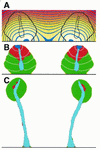How amoeboids self-organize into a fruiting body: multicellular coordination in Dictyostelium discoideum
- PMID: 11274408
- PMCID: PMC31146
- DOI: 10.1073/pnas.061535198
How amoeboids self-organize into a fruiting body: multicellular coordination in Dictyostelium discoideum
Abstract
When individual amoebae of the cellular slime mold Dictyostelium discoideum are starving, they aggregate to form a multicellular migrating slug, which moves toward a region suitable for culmination. The culmination of the morphogenesis involves complex cell movements that transform a mound of cells into a globule of spores on a slender stalk. The movement has been likened to a "reverse fountain," whereby prestalk cells in the upper part form a stalk that moves downwards and anchors to the substratum, while prespore cells in the lower part move upwards to form the spore head. So far, however, no satisfactory explanation has been produced for this process. Using a computer simulation that we developed, we now demonstrate that the processes that are essential during the earlier stages of the morphogenesis are in fact sufficient to produce the dynamics of the culmination stage. These processes are cAMP signaling, differential adhesion, cell differentiation, and production of extracellular matrix. Our model clarifies the processes that generate the observed cell movements. More specifically, we show that periodic upward movements, caused by chemotactic motion, are essential for successful culmination, because the pressure waves they induce squeeze the stalk downwards through the cell mass. The mechanisms revealed by our model have a number of self-organizing and self-correcting properties and can account for many previously unconnected and unexplained experimental observations.
Figures




Comment in
-
Computing an organism.Proc Natl Acad Sci U S A. 2001 Mar 27;98(7):3639-40. doi: 10.1073/pnas.081081998. Proc Natl Acad Sci U S A. 2001. PMID: 11274380 Free PMC article. No abstract available.
References
-
- Savill N J, Hogeweg P. J Theor Biol. 1997;184:229–235. - PubMed
-
- Marée A F M, Panfilov A V, Hogeweg P. J Theor Biol. 1999;199:297–309. - PubMed
-
- Marée A F M, Panfilov A V, Hogeweg P. Proc R Soc London Ser B. 1999;266:1351–1360.
-
- Glazier J A, Graner F. Phys Rev E. 1993;47:2128–2154. - PubMed
-
- Dormann D, Vasiev B, Weijer C J. Biophys Chem. 1998;72:21–35. - PubMed
Publication types
MeSH terms
Substances
LinkOut - more resources
Full Text Sources
Research Materials

